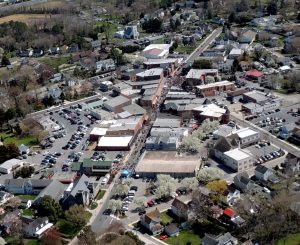
SNOW HILL — The state Department of Assessment and Taxation (SDAT) this week announced the reassessment of one-third of the residential and commercial properties across Maryland, including parts of Worcester and Wicomico, showed their largest increases in value since the 2008 real estate collapse.
Each year, SDAT officials assess the property values of one-third of the residential and commercial properties across the state on a rotating basis in order to determine their assessed values. Locally, Group 2 in Worcester County was reassessed, including much of the south end of the county including Snow Hill, Pocomoke and Newark, for example. Also included in Group 2 in Worcester is much of West Ocean City and all commercial properties in the south end along with commercial properties in Berlin.
The Group 2 reassessment figures released by SDAT this week revealed both residential and commercial properties saw their values increase this year for the first time in many years. In Worcester, the total cash value of all of the residential properties reassessed came in at $2.16 billion compared to $2.06 billion the last time the group was reassessed in 2014, representing an increase of 4.6 percent.
The total cash value of the commercial properties assessed this year in Group 2 came in at nearly $540 million, representing an increase over the $531 million in the last cycle, or about 2.5 percent.
Over in Wicomico, residential and commercial values in the reassessed areas increased even more. For example, the total value of residential properties in Wicomico in the current cycle came in at $1.7 million, representing a 6.4-percent increase over the roughly $1.6 million reported in the last cycle for those areas in 2014. Similarly, the total value of commercial properties in Group 2 in Wicomico came in at nearly $709 million, representing a 6.4-percent increase over the $665 million reported in 2014.
Naturally, in both counties, some property values remained the same and others went down, but a large percentage in both Worcester and Wicomico saw their values increase. For example, of the 10,311 residential properties reassessed in this cycle in Worcester, 6,616 saw their values increase, or nearly 60 percent. Of the 14,820 commercial properties reassessed in Worcester, 6,645, or roughly 45 percent, saw their values increase.
Over in Wicomico, of the 11,026 residential properties reassessed, 7,502, or 68 percent, saw their values increase. Of the 14,608 commercial properties in Wicomico reassessed this time around, 7,768, or 53 percent, saw their values go up.
A look at the assessment value changes over a decade-plus reveal the roller coaster ride the assessments have been on statewide and across Worcester and Wicomico and further illustrate some return to normalcy. For example, the group reassessed in Worcester in 2004, which was on the front edge of remarkable real estate boom in the county, increased by 55 percent. The following year in 2005, the reassessed area in Worcester saw its values increase by just 27 percent, but that was the same area in the south end of the county assessed this year.
In 2006, the reassessed area in Worcester, which included Ocean City, saw its property values increase by a whopping 79 percent. In 2007 and 2008, Worcester saw its values continue to increase by 54 percent and 33 percent, respectively, but the figures show the bottom fall out beginning in 2009.
In 2009, properties reassessed in Worcester saw their values decline by nearly 13 percent. The following year, values in Worcester fell even further by 20 percent. For four more years between 2011 and 2014, Worcester saw its assessment values continue to decline before a modest turnaround began in 2014, or the last time Group 2 was reassessed.
SDAT Supervisor for Worcester County Terri Smith said this week the slight gains seen with the most recent reassessment of the south end of Worcester this week continues a modest return to stability after the sharp peaks and valleys seen through much of the last decade.
“It’s kind of a modest increase, but it’s an increase nonetheless,” she said. “After years of decline, this is the first time this group has seen an increase since the crash beginning in 2008.”
Smith said Group 2, which includes much of the south end of Worcester, is typically insulated somewhat from the high peaks and low valleys because the area is more stable and not subject to the whims of the real estate market quite as much.
“The south end of the county is not as volatile as the north end, largely because of the resort areas in the north end with their typically higher values,” she said. “Traditionally, there is not as much movement in the values on the south end, so an increase no matter how modest is notable.”
The commercial side in Group 2 includes the town of Berlin, which has seen a steady revitalization over the last decade or so which has spiked upward since property values were last reassessed three years ago.
“The commercial properties in Berlin showed an increase,” said Smith. “Of course, Berlin is a pretty happening place right now.”
The residential growth in the south end has been jumpstarted somewhat by the expansion of activity at NASA’s nearby Wallops Flight Facility and in-kind creation of year-round, well-paying jobs. However, Smith pointed out a lot of that residential growth associated with Wallops is also being directed to neighboring Virginia. In addition, Smith said many of the Wallops employees relocating to the Lower Shore are also choosing Berlin and Ocean City, for example, because of the relatively easy commute. However, Smith said the 4.6-percent growth in property values in the south end of Worcester as well as West Ocean City continues to signal a recovery in the market somewhat.
“It’s not a huge increase,” she said. “I think we all remember when Ocean City and the north end were seeing increases of 70 percent just eight or nine years ago. It’s still under where it used to be, but it’s heading in the right direction.”
Increases in property values come with jumps in county property taxes, but most residential property owners in Worcester, particularly in the south end, are protected by the Homestead Cap, which sets a cap on the amount of increase that can be taxed on primary homes. In Worcester, the Homestead Cap is set at 3 percent, meaning year-round, primary residents cannot see their property taxes increase by more than 3 percent regardless of the changes in their assessed values. Smith said the rising values cut both ways for many property owners.
“What we hear all the time from people is they want their values to go up if they are trying to sell their house,” she said. “If they are staying put, naturally they like the values lower because of the taxes.”
With Group 2 now in the books, the SDAT office in Worcester is now setting its sights on Group 3, which includes all of the residential properties in Ocean City along with the commercial properties north of the downtown area. Commercial properties in the downtown area are splintered off and included in Group 1 to make each of the groups more similar in size. Smith said it’s too early to predict what will happen with the reassessment values in Ocean City in the coming year, but they certainly appear to be trending upward.
“I don’t know how that’s going to go because there is so much going on,” she said. “I don’t really see it being a huge spike upward, but you never know. I hope we have some clearer picture by the middle of the year.”

